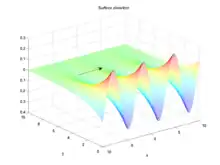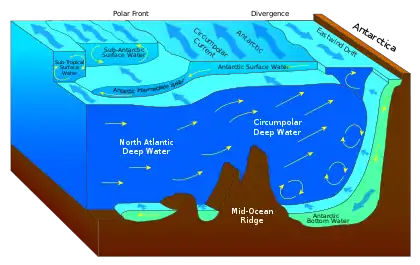Edge wave
In fluid dynamics, an edge wave is a surface gravity wave fixed by refraction against a rigid boundary, often a shoaling beach. Progressive edge waves travel along this boundary, varying sinusoidally along it and diminishing exponentially in the offshore direction.[1]

Example of the surface elevation of a progressive edge wave
References
- Lamb, Horace (1932), Hydrodynamics, Cambridge: Cambridge University Press, p. 446, ISBN 0-521-45868-4
Further reading
- Ursell, F. (1952), "Edge waves on a sloping beach", Proceedings of the Royal Society of London. Series A, Mathematical and Physical Sciences, 214 (1116): 79–97, Bibcode:1952RSPSA.214...79U, doi:10.1098/rspa.1952.0152, S2CID 122032422
- Miles, J.W. (1989), "Edge waves on a gently sloping beach", Journal of Fluid Mechanics, 199: 125–131, Bibcode:1989JFM...199..125M, doi:10.1017/S0022112089000315, S2CID 122744100
- Chapman, C.J. (2001), "Energy paths in edge waves", Journal of Fluid Mechanics, 426 (1): 135–154, Bibcode:2001JFM...426..135C, doi:10.1017/S0022112000002184, S2CID 119424411
This article is issued from Wikipedia. The text is licensed under Creative Commons - Attribution - Sharealike. Additional terms may apply for the media files.

